

| November 1959 |
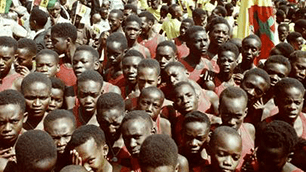 |
| Celebrating independence in Kigali. © United Nations |
| Hutu farmers rise against Tutsi dominance in what is known as the “social revolution” or “Rwandan All Saints' Day”. As Tutsis massacres take place for the first time, many seek refuge in neighbouring countries. Violent clashes pit supporters of the Party for the Emancipation of Hutus (Parmehutu) against the Tutsi monarchists of the Rwanda National Union (UNAR). Parmehutu proclaims Rwanda a republic, Belgium abandons its Tutsi allies, officially grants independence on July 1, 1962. Hutus remain in power until the 1994 genocide. |


| Interacting through photographic portraits |
 |
| Nowadays in Rwanda, it's very difficult to openly discuss certain matters. Referring to any type of ethnic identity can lead to jail, as can criticising the government's development policies. Rwandans are also shy about publicly expressing personal opinions, which is why the project based itself on individual portraits, taken behind closed doors. In order to break down barriers with witnesses, to make interactions more lively and more intimate, and to focus on each person and their story, regardless of their ethnic or social group, the project used a specific photographic concept. The concept of Polaroid and “unique” photo was made possible thanks to a 1937 camera (Speed Graphic + Aero Ektar lens + Fuji film), with the photo being developed immediately. Two shots were taken each time: one print was given to the person who was photographed, and the other was included in this project. Thus interactions centred around the shots taken by artist and photographer Arno Lafontaine. |











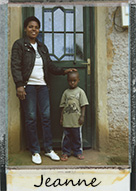
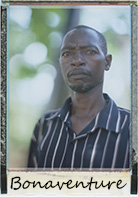
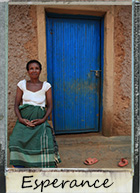
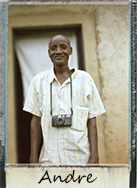
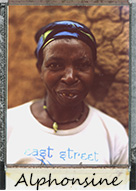
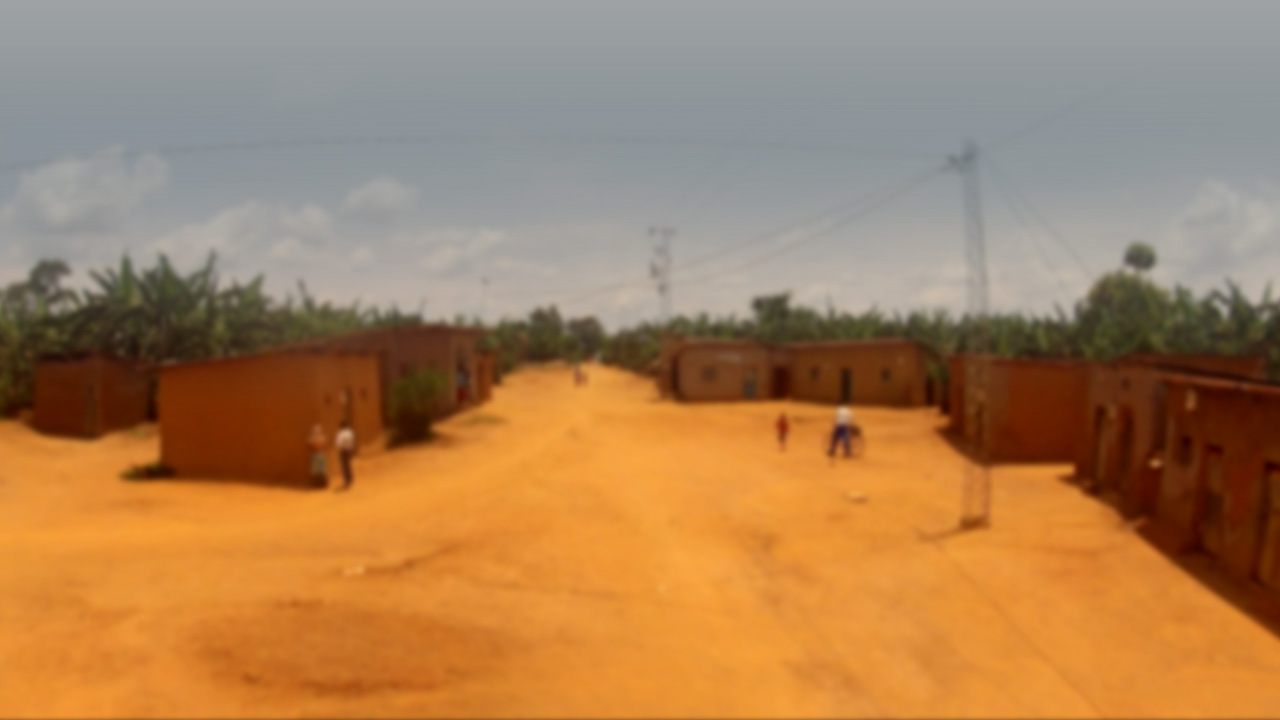
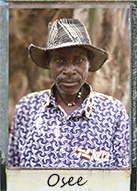










| 1959- 1963 |
| Tutsi military units repeatedly lead raids from Burundi, meanwhile anti-Tutsi pogroms take place in Rwanda. In 1963, exiled Tutsis launch a military attack, 10,000 Tutsis are killed in reprisal and their leaders are executed. Between 1959 and 1963, some 300,000 Rwandan Tutsis, half of Rwanda's Tutsi population, go into exile.
|
| July 5, 1973 |
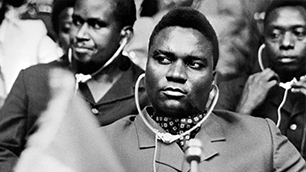 |
| Juvénal Habyarimana on August 3, 1975 at the African Union summit in Kampala. © AFP
|
| General Juvénal Habyarimana (a Hutu) topples President Grégoire Kayibanda, assumes power. More Tutsis are massacred. Habyarimana is elected president in 1978, 1983 and 1988. |
| October 1, 1990 |
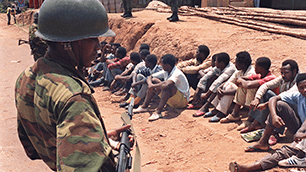 |
| Tutsis and political opponents are arrested in Kigali on October 1, 1990. © AFP |
| The civil war begins after the Tutsi-dominated Rwandan Patriotic Front (RPF, created in 1987 by exiled Rwandans) invades from Uganda, whose government supports the RPF. Zaire, Belgium and France send President Habyarimana military assistance. Some 10,000 Rwandan Tutsis and opponents are arrested in Rwanda's capital Kigali. |
| April 1993 |
| Businessmen and political allies of President Habyarimana found the radio and TV station Radio-télévision libre des Milles Collines (RTLMC, Thousand Hills Free Radio and TV). The station broadcasts hate programmes aimed at inflaming Rwandans against Tutsis and moderate Hutus. |
| April 6, 1994 |
| The plane carrying Rwandan President Juvénal Habyarimana and his Burundian counterpart Cyprien Ntaryamira back from a regional summit in Tanzania is shot down. |
| April 7, 1994 |
 |
| 4,000 people were killed in a church in Nyarubuye on May 25, 1994. © Getty Images |
| The attack enrages Hutu extremists, and sparks the beginning of the large-scale massacre of Tutsis and moderate Hutus. Over the course of 100 days, an estimated 800,000 people are killed. An interim government of Hutu extremists is appointed, with Jean Kambanda as prime minister. Between April 9 and 17, France evacuates French nationals as well as high-ranking Rwandans including the family of late President Habyramina, who are flown to Paris. On April 21, soldiers kill Prime Minister Agathe Uwilingiyimana (a moderate Hutu), along with ten Belgian peacekeepers from the United Nations Assistance Mission for Rwanda. The UN decreases its peacekeeping presence from 2,500 to 270 troops. |
| May 1994 |
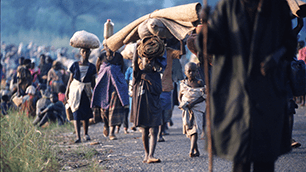 |
| Mass exodus towards Tanzania, April 30, 1994. © Getty Images
|
| UN Commissionner José Avalo Lasso calls the unfolding events a “genocide” during his visit to Kigali. On May 22, 1994, the RPF takes control of Kanombe military camp and Kigali airport. On May 29, the interim government flees Gitarama. Hundreds of thousands of Hutu civilians flee the south-eastern part of the country before the advance of the RPF, who closes the border with Tanzania to prevent them from seeking refuge there. |
| June 22, 1994 |
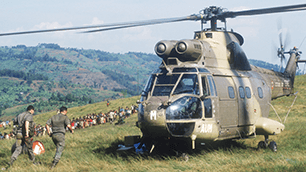 |
| French soldiers near Nyarushishi refugee camp, June 26, 1994. © Getty Images |
| France, under mandate from the UN, begins “Operation Turquoise”: 2,500 French troops, along with several African contingents, are deployed to south-west Rwanda as well as in refugee camps in Zaire, to create a “safe area”. The RPF accuses France, a long-time ally of the Hutu government, of protecting extremists in that area. |
| July 4, 1994 |
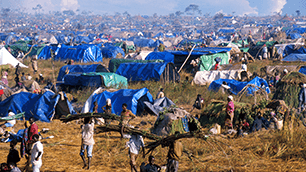 |
| Benako refugee camp in Tanzania. © Getty Images |
| The RPF's Tutsi rebels take over Butare and enter Kigali after three months of violent fighting. Some 1.2 million Rwandan Hutus flee to neighbouring countries. Many head for the region of Kivu in eastern Zaire. |
| July 17, 1994 |
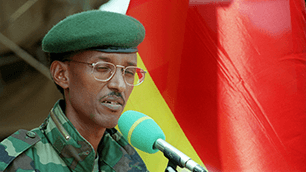 |
| Paul Kagame on July 20, 1994 in Kigali. © AFP |
| Faustin Twagiramungu, a moderate Hutu, forms a coalition government. Another moderate Hutu, Pasteur Bizimungu is named president of the republic, while Paul Kagame, leader of the rebel RPF, is named vice-president and minister of defence. The next day, the RPF declares the war over and announces a de facto ceasefire. |
| November 8, 1994 |
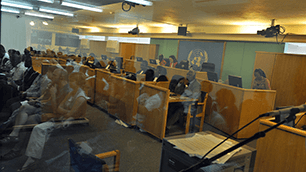 |
| © AFP |
| The UN Security Council appoints an international court (the International Criminal Tribunal for Rwanda, located in Arusha, Tanzania) to prosecute people responsible for acts of genocide and for other serious violations of international humanitarian law committed in Rwanda territory, or by Rwandan nationals in neighbouring countries between January 1 and December 31, 1994. On December 9, 1994, a UN commission publishes a report saying that Hutu extremists carried out concerted and planned acts of genocide, in order to destroy Rwanda's Tutsi minority. |
| January 9, 1997 |
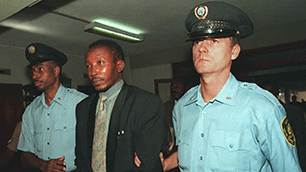 |
| Jean-Paul Akayesu. © AFP |
| The first case of genocide comes before the International Criminal Tribunal for Rwanda: Jean-Paul Akayesu, former mayer of Taba, stands trial on counts of genocide, crimes against humanity, and sexual assault. He is found guilty of genocide on September 2, 1998, and sentenced to life imprisonment. For the first time, the court recognises rape as an act of genocide. |
| May 1, 1998 |
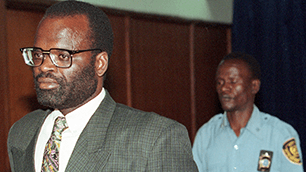 |
| Jean Kambanda. © AFP |
| Jean Kambanda, who was interim prime minister during the worst of the killings, pleads guilty to the following counts: genocide, conspiracy to commit genocide, incitement to commit genocide, aiding and abetting genocide, crimes against humanity (murder and extermination). He had also admitted to having handed out weapons and confirmed that the genocide had been planned. |
| April 17, 2000 |
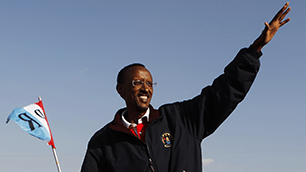 |
| Paul Kagame during the 2010 election. © Reuters
|
| President Pasteur Bizimungu (a Hutu) resigns, Vice-President Paul Kagame is elected president by the Parliament. He is re-elected by direct vote on August 25, 2003 and again on August 9, 2010. On June 7, 2004, Pasteur Bizimungu is sentenced to 15 years in jail. He is pardoned on April 6, 2007. |
| January 1, 2003 |
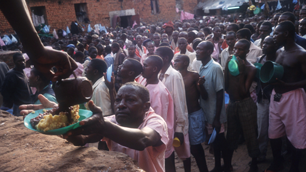 |
| © Getty Images
|
| Paul Kagame signs a decree to free 30,000 to 40,000 prisoners – a third of the total number of Rwandans detained for allegedly taking part in the 1994 genocide. Among those eligible for release are the elderly (aged 70 or more), the sick, those who were minors at the time and those who have confessed and have already spent longer time behind bars than the sentence they face. Not eligible for release are the masterminds, those accused of sexual assault, and those who killed many people during the genocide. |
| March 10, 2005 |
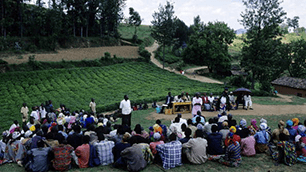 |
| A gacaca court in the Rwandan village of Gotovo in 2003. © Getty Images |
| Traditional “gacaca” community courts begin hearings in 106 test communities, then across the entire country. Paul Kagama reinstates “gacaca” courts in 2002, when authorities say it would take more than 100 years to organise trials for the 130,000 Rwandans detained. Nearly 2 million people – none suspected of organising or masterminding the genocide, or facing the death penalty – appeared before these courts. Hearings in gacaca courts officially ended on June 18, 2012. |
| November 2006 |
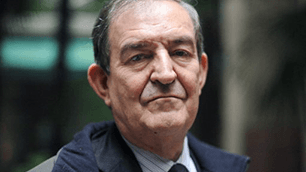 |
| Jean-Louis Bruguière © AFP
|
| After eight years of investigation, French judge Jean-Louis Bruguière hands in a report calling for Paul Kagame to be prosecuted by the International Criminal Tribunal for Rwanda for allegedly taking part in the attack against Juvénal Habyarimana. He then issues nine arrest warrants against close allies of Kagame's. Rwanda retaliates by breaking off diplomatic ties with France and appeals to the International Criminal Court in The Hague. |
| December 18, 2008 |
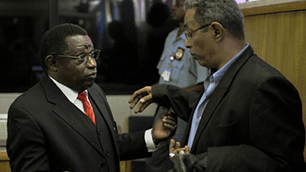 |
| Theoneste Bagosora (left) with one of his lawyers, at the International Criminal Tribunal for Rwanda. © AFP
|
| Theoneste Bagosora, former chief of staff at the ministry of defence, is sentenced to life imprisonment for genocide, crimes against humanity and war crimes. He is considered to be the mastermind behind the genocide. |
| September 2010 |
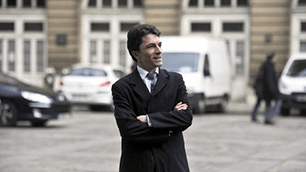 |
| Marc Trevidic. © AFP |
| French judge Marc Trevidic travels to Rwanda to investigate the attack against the plane carrying President Habyarimana. According to his January 2012 report, it is impossible to determine whether the RPF or Hutu extremists were behind the attack, but it is likely that the missiles were shot from Kanombe military camp or nearby, an area controlled by military units allied with Hutu extremists. |
| February 3, 2014 |
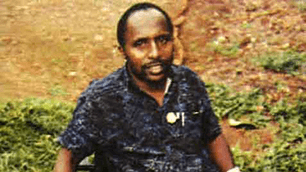 |
| Pascal Simbikangwa © Interpol |
| In the first case brought before a French criminal court, the trial of Pascal Simbikangwa opens in Paris. On March 14, the court convicts him for his role in the 1994 killings and sentences him to 25 years in prison. |


